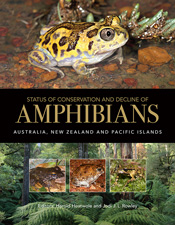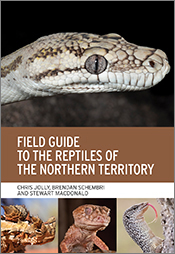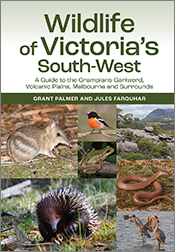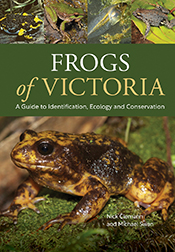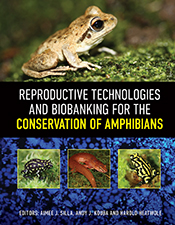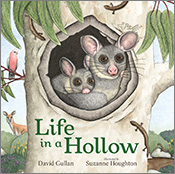Status of Conservation and Decline of Amphibians
Australia, New Zealand, and Pacific Islands
Edited by: Harold Heatwole, Jodi J. L. RowleyAims to stimulate research into halting amphibian declines and to improve decisions about conservation.
Amphibians are among the most threatened groups of animals on earth. In part due to their highly permeable skin, amphibians are highly sensitive to environmental changes and pollution and provide an early-warning system of deteriorating environmental conditions. The more we learn about the impact of environmental changes on amphibians, the better we as humans will be able to arrest their demise, and our own. + Full description
Status of Conservation and Decline of Amphibians brings together the current knowledge on the status of the unique frogs of Australia, New Zealand, and the Pacific. Although geographically proximate, each region presents unique challenges and opportunities in amphibian research and conservation. This book contributes to an understanding of the current conservation status of the amphibians of each region, aims to stimulate research into halting amphibian declines, and provides a better foundation for making conservation decisions. It is an invaluable reference for environmental and governmental agencies, researchers, policy-makers involved with biodiversity conservation, and the interested public.
- Short descriptionReviews
"This is a beautiful publication, and the editors are to be congratulated on an extremely thorough synthesis and appraisal of available information, requiring an immense amount of work."
iHerp Australia Magazine 2019
Details
Hardback | June 2018 | $160.00ISBN: 9781486308385 | 248 pages | 270 x 210 mm
Publisher: CSIRO Publishing
Graphs, Photographs
ePDF | June 2018
ISBN: 9781486308392
Publisher: CSIRO Publishing
Available from eRetailers
ePUB | June 2018
ISBN: 9781486308408
Publisher: CSIRO Publishing
Available from eRetailers
Features
- Contains expert analysis of the conservation status of frogs in different regions within Australia, New Zealand and the Pacific Islands as well as the threats they face
- Provides recommendations for future monitoring, research and legislation and a benchmark against which future threats can be assessed and effectiveness of conservation measures evaluated
- This book is Volume 11 (Status of Conservation and Decline of Amphibians: Eastern Hemisphere), Part 6 (Australia, New Zealand, and Pacific Islands) of the Amphibian Biology series
Contents
PrefaceContents of Previous Parts of Volume 11
Contributors to Part 6
Chapter 1: Introduction
Chapter 2: A Brief Demographic Overview of Australia’s Native Amphibians
Chapter 3: Status of Decline and Conservation of Frogs in the Wet Tropics of Australia
Chapter 4: Frogs of the Monsoon Tropical Savannah Regions of Northern Australia
Chapter 5: An Update on Frog Declines from the Forests of Subtropical Eastern Australia
Chapter 6: Frog Declines and Associated Management Response in South-eastern Mainland Australia and Tasmania
Chapter 7: The Status of Decline and Conservation of Frogs in Temperate South-eastern Australia
Chapter 8: The Status of Conservation of Frogs in South-western Australia
Chapter 9: The Status of Decline and Conservation of Frogs in the Arid and Semi-arid Zones of Australia
Chapter 10: The Impact of an Invasive Amphibian: The Cane Toad, Rhinella marina
Chapter 11: The Role of Ex Situ Amphibian Conservation in Australia
Chapter 12: Conservation of Frogs in Australia: State and Federal Laws---Who is Responsible?
Chapter 13: Status of Decline and Conservation of Frogs in New Zealand
Chapter 14: Amphibians of the Pacific: Natural History and Conservation
Index
View the full table of contents (PDF, 491kb)
Authors
Harold Heatwole is Adjunct Professor of Zoology at the University of New England in Australia and Professor Emeritus of Biology at North Carolina State University in the USA. He was Editor-in-Chief of the journal Integrative and Comparative Biology for 10 years and has edited two successful series of books: Ecology in Australia (seven volumes) and Amphibian Biology (of which the present book is volume 11).
Jodi J. L. Rowley is the Curator of Amphibian and Reptile Conservation Biology at the Australian Museum and UNSW Sydney. She has been an Editor for the international scientific journal Zootaxa since 2012. She is a Regional Chair of the IUCN Species Survival Commission Amphibian Specialist Group, a Regional Coordinator for the IUCN Amphibian Red List Authority, and a member of the NSW Scientific Committee.
Contributors:
Ross A. Alford, Ben D. Bell, Phillip J. Bishop, Kay Bradfield, Philip Byrne, Nick Clemann, Harold G. Cogger, David Coote, Murray Evans, Robert N. Fisher, Deon Gilbert, Graeme R. Gillespie, Greg Hollis, David Hunter, Frank Lemckert, Michael Mahony, Gerry Marantelli, Michael McFadden, David Newell, Joanne Ocock, Annie Philips, J. Dale Roberts, Ben Scheele, Richard Shine, Skye Wassens, Matt West, and George Zug

